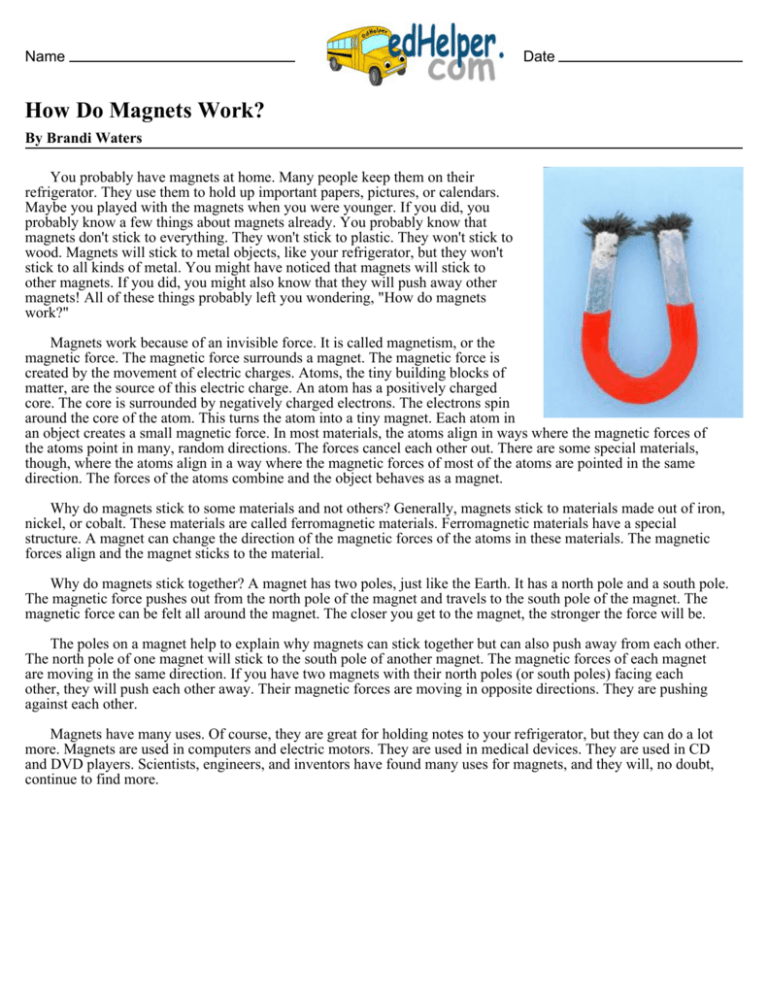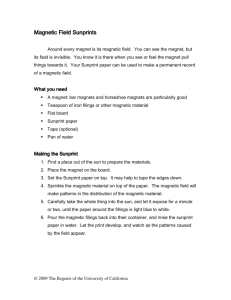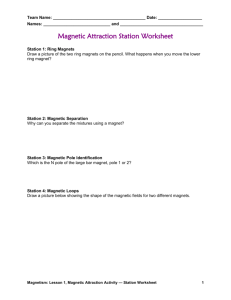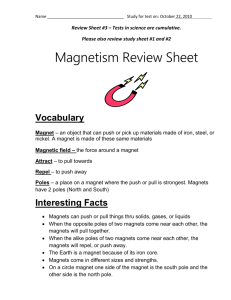How Do Magnets Work?
advertisement

Name Date How Do Magnets Work? By Brandi Waters You probably have magnets at home. Many people keep them on their refrigerator. They use them to hold up important papers, pictures, or calendars. Maybe you played with the magnets when you were younger. If you did, you probably know a few things about magnets already. You probably know that magnets don't stick to everything. They won't stick to plastic. They won't stick to wood. Magnets will stick to metal objects, like your refrigerator, but they won't stick to all kinds of metal. You might have noticed that magnets will stick to other magnets. If you did, you might also know that they will push away other magnets! All of these things probably left you wondering, "How do magnets work?" Magnets work because of an invisible force. It is called magnetism, or the magnetic force. The magnetic force surrounds a magnet. The magnetic force is created by the movement of electric charges. Atoms, the tiny building blocks of matter, are the source of this electric charge. An atom has a positively charged core. The core is surrounded by negatively charged electrons. The electrons spin around the core of the atom. This turns the atom into a tiny magnet. Each atom in an object creates a small magnetic force. In most materials, the atoms align in ways where the magnetic forces of the atoms point in many, random directions. The forces cancel each other out. There are some special materials, though, where the atoms align in a way where the magnetic forces of most of the atoms are pointed in the same direction. The forces of the atoms combine and the object behaves as a magnet. Why do magnets stick to some materials and not others? Generally, magnets stick to materials made out of iron, nickel, or cobalt. These materials are called ferromagnetic materials. Ferromagnetic materials have a special structure. A magnet can change the direction of the magnetic forces of the atoms in these materials. The magnetic forces align and the magnet sticks to the material. Why do magnets stick together? A magnet has two poles, just like the Earth. It has a north pole and a south pole. The magnetic force pushes out from the north pole of the magnet and travels to the south pole of the magnet. The magnetic force can be felt all around the magnet. The closer you get to the magnet, the stronger the force will be. The poles on a magnet help to explain why magnets can stick together but can also push away from each other. The north pole of one magnet will stick to the south pole of another magnet. The magnetic forces of each magnet are moving in the same direction. If you have two magnets with their north poles (or south poles) facing each other, they will push each other away. Their magnetic forces are moving in opposite directions. They are pushing against each other. Magnets have many uses. Of course, they are great for holding notes to your refrigerator, but they can do a lot more. Magnets are used in computers and electric motors. They are used in medical devices. They are used in CD and DVD players. Scientists, engineers, and inventors have found many uses for magnets, and they will, no doubt, continue to find more. Name Date How Do Magnets Work? Questions 1. Magnets stick to materials made out of ______. A. wood B. plastic C. copper D. none of the above 2. The invisible force that surrounds a magnet is called the ______. 3. ______ is a ferromagnetic material. A. Aluminum B. Iron C. Copper D. all of the above 4. Two magnets will repel each other when ______. A. their magnetic forces are pushing against each other B. their north poles are facing each other C. their south poles are facing each other D. all of the above 5. The ______ surrounding the core of an atom create a small magnetic force. Explain why two magnets will stick together. Draw a picture to help explain. Draw lines to show the magnetic field. Draw arrows to show which direction the magnetic field is moving. Name Date The Earth has a rocky surface that covers a core filled with liquid rock and metal. Most scientists believe that iron and nickel make up most of the Earth's core. Use what you have learned to explain how a compass, a magnetized needle, works.







